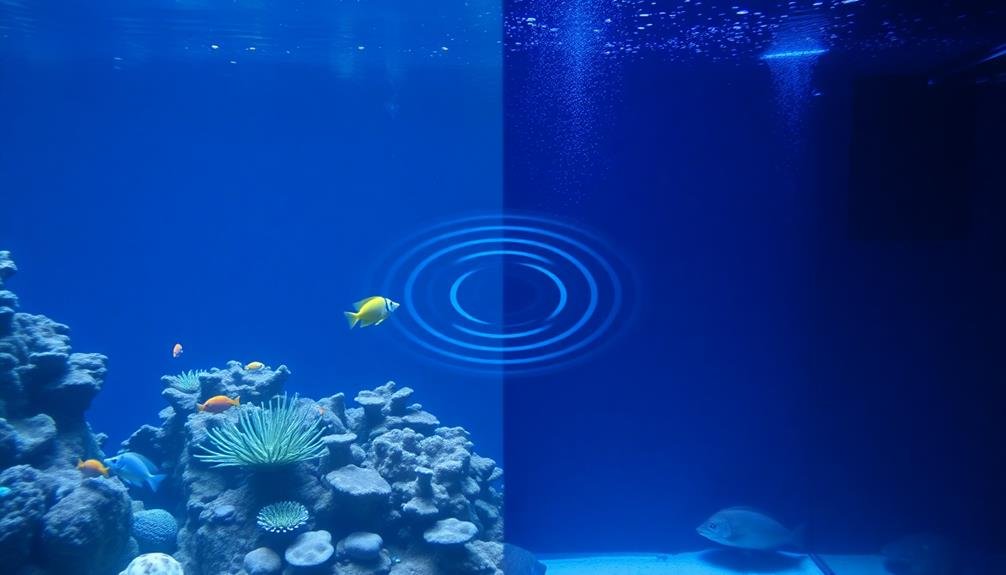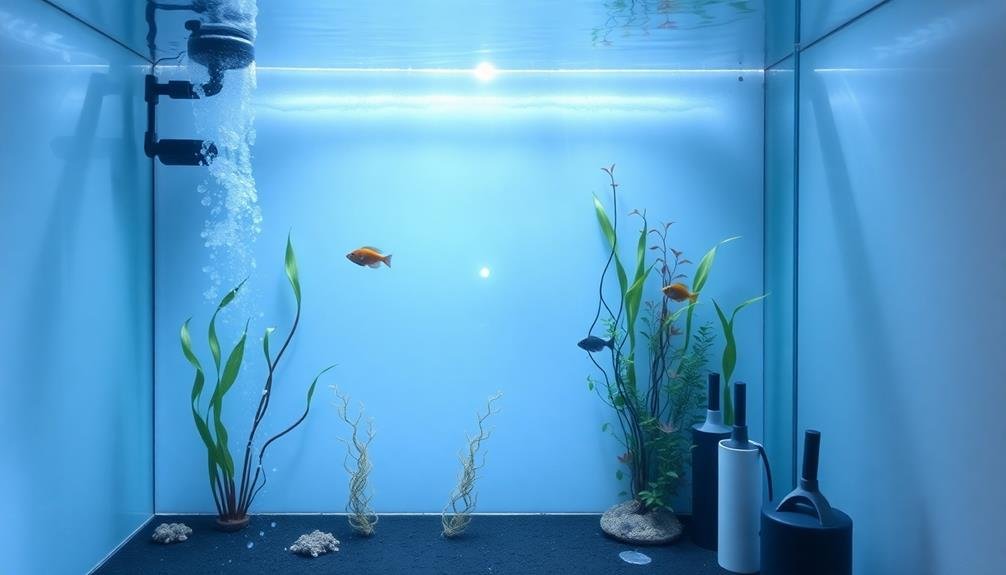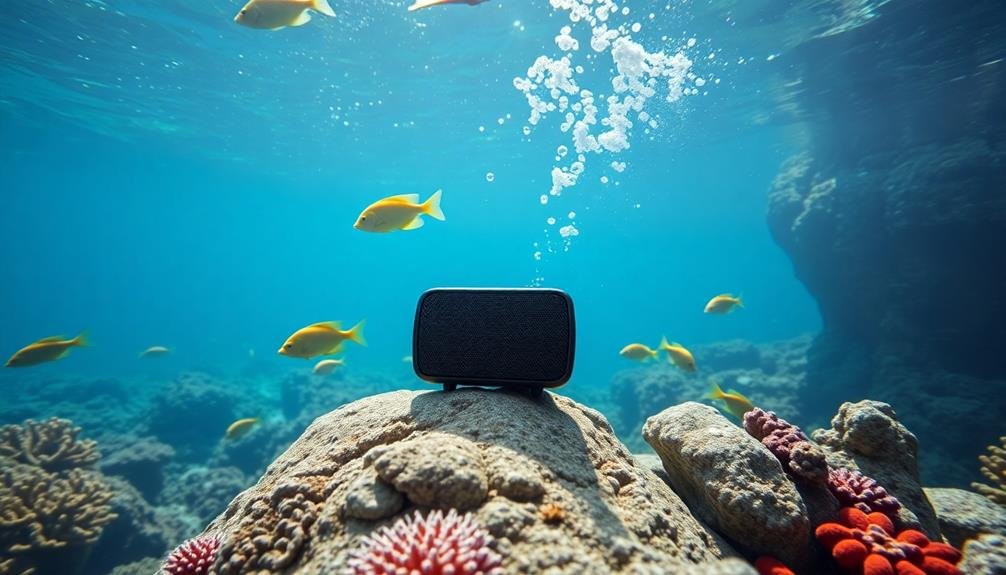Underwater aquarium sounds can greatly ease your anxious mind through their unique auditory properties. Water's density enhances sound transmission, creating a rich, immersive experience. You'll benefit from improved sleep, enhanced concentration, and reduced anxiety. Gentle bubbling, soft ocean waves, and soothing fish tank ambience are just a few calming noises to explore. Set up your aquarium soundscape with the right equipment and fish species for best results. Combine these soothing sounds with visuals for a more complete sensory experience. Whether you're at home or on the go, portable solutions make it easy to carry this tranquil underwater world with you. Dive deeper to uncover the full potential of aquatic serenity.
The Science Behind Underwater Sounds

Three key factors contribute to the unique nature of underwater sounds in aquariums.
First, water's density affects sound transmission, allowing it to travel faster and farther than in air. This means you'll hear underwater noises with greater clarity and intensity.
Second, the enclosed environment of an aquarium creates a reverberant space, enhancing and amplifying sounds. You'll notice echoes and reflections that add depth to the acoustic experience.
Lastly, the diverse sources of underwater sounds in aquariums create a rich auditory landscape. You'll hear bubbles from aeration systems, the gentle hum of filtration equipment, and the subtle movements of aquatic life. These elements combine to form a soothing soundscape that's both natural and artificial.
Understanding these factors helps explain why underwater aquarium sounds can be so calming. The consistent, low-frequency noises mask disruptive external sounds, while the rhythmic patterns of bubbles and water movement can induce a meditative state.
It's this unique combination of acoustic properties and sound sources that makes aquarium soundscapes an effective tool for reducing anxiety and promoting relaxation.
Benefits of Aquarium Soundscapes
Numerous benefits arise from listening to aquarium soundscapes. These calming underwater sounds can greatly impact your mental and physical well-being.
When you immerse yourself in the gentle bubbling, soft water movements, and occasional fish noises, you'll find your stress levels decreasing and your mind becoming more focused.
Aquarium soundscapes can help you:
- Improve sleep quality by creating a soothing bedtime environment
- Enhance concentration during work or study sessions
- Reduce anxiety and promote relaxation
- Mask disruptive background noises in your surroundings
- Stimulate creativity and imagination
Types of Calming Aquatic Noises

When you're looking to create a calming aquatic atmosphere, you'll find several types of soothing underwater sounds to choose from.
You can opt for gentle bubbling water sounds that mimic the tranquil flow of a stream or soft ocean wave rhythms that transport you to a peaceful seaside.
If you prefer a more contained aquatic environment, soothing fish tank ambience can provide a serene backdrop with its subtle filtration hums and gentle water movements.
Gentle Bubbling Water Sounds
As you approach an aquarium, one of the first sounds you'll notice is the gentle bubbling of water. This soothing noise comes from various sources within the tank, creating a calming atmosphere that can help ease your anxious mind. The bubbling sounds are primarily produced by air pumps, filters, and decorative elements designed to mimic natural underwater environments.
These gentle bubbling water sounds offer several benefits:
- Mask background noise, creating a more peaceful environment
- Promote relaxation and reduce stress levels
- Improve focus and concentration
- Enhance sleep quality when used as white noise
- Stimulate creativity and productivity
You'll find that the intensity and rhythm of bubbling sounds can vary depending on the aquarium's setup. Some tanks feature a constant, steady stream of bubbles, while others may have intermittent bursts or a combination of different bubble sizes.
The size of the tank, the type of filtration system, and the presence of air stones or decorative bubblers all contribute to the unique soundscape of each aquarium. By immersing yourself in these gentle bubbling water sounds, you can experience a sense of tranquility and connection to the underwater world.
Soft Ocean Wave Rhythms
The gentle ebb and flow of soft ocean wave rhythms can transport you to a serene coastal environment. These soothing sounds replicate the steady, rhythmic lapping of waves against the shore, creating a calming atmosphere in your aquarium space.
You'll notice that soft ocean wave sounds typically consist of a low, continuous rumble punctuated by gentle swells. This natural pattern mimics the ocean's breathing, helping to regulate your own breathing and heart rate. As you listen, you may find yourself synchronizing with the waves' rhythm, naturally inducing a state of relaxation.
These sounds can be particularly effective in masking disruptive background noise, making them ideal for use in busy households or office environments. You can adjust the volume to create a subtle ambiance or a more immersive experience.
Many aquarium enthusiasts incorporate soft ocean wave sounds into their setups using underwater speakers or external sound systems. You'll find that these rhythms complement the visual elements of your aquarium, enhancing the overall sensory experience and creating a more realistic underwater environment for both you and your aquatic pets.
Soothing Fish Tank Ambience
Beyond soft ocean waves, a variety of soothing fish tank ambience sounds can create a tranquil aquatic atmosphere.
You'll find that these gentle noises can transport you to an underwater oasis, helping to calm your mind and reduce stress. The subtle bubbling of air stones, the gentle hum of filters, and the occasional splash of fish can combine to form a soothing underwater symphony.
To enhance your relaxation experience, consider incorporating these fish tank ambience elements:
- Gentle water trickles from small cascades or waterfalls
- Soft, rhythmic bubbling from air stones or protein skimmers
- Low-frequency hums from filtration systems
- Muted splashes as fish break the water's surface
- Faint echoes of sound reverberating through the tank
These aquatic sounds can mask disruptive background noise, creating a peaceful environment for work, sleep, or meditation.
You'll notice that the consistent, low-level ambient noise helps to improve focus and promote a sense of calm.
Setting Up Your Aquarium Soundscape
Creating your aquarium soundscape begins with selecting the right equipment and positioning it strategically. Choose a high-quality underwater speaker designed for aquarium use, ensuring it's waterproof and safe for your aquatic inhabitants. Place the speaker in a corner or behind decorations to create a natural sound dispersion.
Next, select your audio source. You can opt for pre-recorded aquarium sounds or create a custom mix using a smartphone or digital audio player. Consider incorporating gentle bubbling, soft water movements, and subtle marine life sounds for a realistic underwater atmosphere.
Adjust the volume carefully, starting low and gradually increasing until you achieve the desired ambience. Remember, fish are sensitive to vibrations, so keep the sound at a comfortable level for both you and your aquatic friends.
Experiment with different sound combinations and durations. You might prefer continuous play or set specific times for your aquarium soundscape. Use a timer or smart plug to automate the process if desired.
Lastly, maintain your equipment regularly. Clean the speaker as recommended by the manufacturer and update your playlist occasionally to keep the experience fresh and engaging.
Best Fish for Soothing Sounds

You'll find that certain fish species can contribute to a more soothing aquarium soundscape.
Betta fish tanks often produce gentle bubbling sounds, while goldfish create soft water movements as they swim.
If you're looking for a more immersive experience, saltwater reef tanks can offer a range of calming underwater sounds reminiscent of ocean environments.
Bubbling Betta Fish Tanks
Bubbling gently, betta fish tanks offer some of the most soothing aquatic sounds for your home or office. These compact aquariums create a tranquil atmosphere with their soft, continuous bubbling.
You'll find that the sound of water trickling through filters and air stones can help mask background noise and promote relaxation.
When setting up your betta tank for ideal sound, consider these elements:
- Tank size: Larger tanks produce more robust bubbling sounds
- Filter type: Hang-on-back filters create gentle waterfall effects
- Air stones: Increase oxygenation and bubbling intensity
- Substrate: Gravel amplifies underwater sounds more than sand
- Decorations: Hollow ornaments can create unique water flow patterns
To enhance the calming effects, place your betta tank in a quiet area where you can fully appreciate its soothing sounds.
You might even add a small fountain or water feature to complement the aquarium's ambiance.
Remember to maintain proper water quality and temperature for your betta's health, as a happy fish will be more active and contribute to the overall soundscape.
With the right setup, your bubbling betta fish tank can become a focal point for relaxation and stress relief in your space.
Gentle Goldfish Water Movement
While betta fish tanks offer soothing bubbles, goldfish aquariums provide a different kind of auditory experience.
You'll find that the gentle water movement in a goldfish tank creates a subtle, calming sound that can ease your anxious mind. The key lies in the filter system, which circulates water at a slower pace, producing a soft, continuous flow.
As you listen to a goldfish aquarium, you'll notice the gentle lapping of water against the tank's edges. This sound mimics the peaceful ambiance of a serene pond or slow-moving stream.
The larger size of goldfish tanks also contributes to the soothing effect, as the increased water volume creates a deeper, more resonant sound.
You can enhance these calming sounds by adding natural elements to your goldfish tank. Smooth river rocks or driftwood can create gentle eddies and swirls in the water flow, adding layers to the auditory experience.
Live plants, such as water lilies or hornwort, will sway gently in the current, producing a soft rustling sound that complements the water's movement.
Soothing Saltwater Reef Sounds
Saltwater reef aquariums often provide the most diverse and enchanting soundscape of all aquarium types.
You'll hear a symphony of gentle bubbling, soft splashing, and the subtle movements of marine life. These sounds can transport you to a tranquil underwater world, helping to ease anxious thoughts and promote relaxation.
When setting up your reef tank for ideal soothing sounds, consider incorporating these elements:
- A protein skimmer for consistent, gentle bubbling
- A hang-on-back filter for a soft, trickling water sound
- Live rock to create natural water movement and hiding spots for fish
- A wavemaker to simulate ocean currents
- A small powerhead to generate subtle background noise
The best fish for creating soothing sounds in a saltwater reef aquarium are typically smaller, active species.
Clownfish, with their playful darting movements, can produce soft splashing sounds. Tangs and wrasses, known for their constant grazing, create gentle rustling noises as they swim through coral and rocks.
Aquarium Equipment for Optimal Audio
The right equipment can transform your aquarium into an auditory oasis. To achieve ideal underwater sounds, you'll need a high-quality submersible pump. Choose one with adjustable flow rates to fine-tune the water movement and resulting sound. Position it strategically to create gentle currents and bubbling effects.
Consider adding an air pump and air stone combination. This setup produces a steady stream of bubbles, creating a soothing background noise. Experiment with different sizes and types of air stones to vary the sound intensity.
Incorporate a protein skimmer for saltwater tanks. It not only improves water quality but also generates a soft, continuous trickling sound. For freshwater setups, a hang-on-back filter can provide a similar auditory effect.
Don't overlook the importance of your tank's location. Place it away from noisy appliances or high-traffic areas to minimize external interference. A well-insulated stand can help reduce vibrations that might disrupt the aquatic soundscape.
Lastly, invest in a quality hydrophone if you want to truly immerse yourself in the underwater audio experience. This specialized microphone allows you to record and amplify the subtle sounds of your aquatic ecosystem.
Natural vs. Artificial Underwater Sounds

Aquarium enthusiasts often debate the merits of natural versus artificial underwater sounds. You'll find that both have their advantages and drawbacks.
Natural sounds, like bubbling water and the gentle swish of fish swimming, create an authentic atmosphere. They're soothing and can transport you to a real underwater environment. However, these sounds can be unpredictable and may not always provide the consistent ambiance you're looking for.
Artificial sounds, on the other hand, offer more control and customization. You can choose from a variety of pre-recorded underwater soundscapes or even create your own. These sounds are often clearer and can be adjusted to your preferred volume and frequency. However, some argue that artificial sounds lack the organic quality of natural ones.
When deciding between natural and artificial sounds, consider:
- Your aquarium's size and inhabitants
- The level of ambient noise in your space
- Your personal preference for authenticity vs. consistency
- The therapeutic goals you're trying to achieve
- The maintenance required for each option
Ultimately, the choice between natural and artificial underwater sounds depends on your specific needs and preferences. You might even find that a combination of both works best for creating your ideal aquatic soundscape.
Incorporating Visuals With Sounds
Enhancing your underwater soundscape with visuals can create a truly immersive experience. When you combine soothing aquatic sounds with matching imagery, you'll engage multiple senses simultaneously, amplifying the calming effect.
Consider using a large aquarium or a high-quality video display to showcase vibrant underwater scenes that complement your chosen audio. You can synchronize gentle water movements with the sounds of bubbles or flowing currents.
Incorporate footage of colorful fish gliding through coral reefs, accompanied by soft, melodic tones. For a more serene atmosphere, pair slow-moving jellyfish or swaying seagrass with ambient underwater drones.
Don't limit yourself to just fish and coral. Include scenes of sea turtles gracefully swimming, dolphins playfully interacting, or even the mesmerizing patterns of light filtering through the water's surface. These visuals can be timed to match the rhythm and intensity of your underwater soundscape.
Remember to maintain a balance between visual stimulation and tranquility. Avoid overly busy or chaotic scenes that might detract from the calming effect you're aiming to achieve.
Maintenance for Consistent Sound Quality

To keep your underwater soundscape in top form, regular maintenance is key. You'll need to check your equipment regularly and address any issues promptly. Clean your speakers and other components to prevent buildup that could affect sound quality. Monitor water levels and adjust as needed, as changes can impact sound transmission.
Pay attention to the following maintenance tasks:
- Check and replace batteries in wireless devices
- Inspect cables and connections for wear or corrosion
- Clean speaker grills and membranes gently
- Calibrate volume levels periodically
- Update software for digital sound systems
Don't forget to listen critically to your underwater sounds regularly. You'll want to guarantee they're still achieving the desired calming effect. If you notice any distortions or changes in quality, troubleshoot immediately.
Keep a log of your maintenance activities and any adjustments you make. This will help you track patterns and anticipate when components might need replacement or upgrades.
Nighttime Aquarium Sound Therapy
As you turn off the lights and settle in for the night, your aquarium can transform into a soothing sound therapy device.
You'll find the gentle bubbling and currents create a calming nocturnal water ambience that promotes relaxation and better sleep.
The subtle sounds of fish movements add to this tranquil underwater symphony, helping you unwind and drift off peacefully.
Soothing Nocturnal Water Ambience
Nighttime aquarium sounds offer a unique form of sound therapy for those seeking tranquility after dark. As you lie in bed, these soothing nocturnal water ambiences can transport you to a peaceful underwater world. The gentle bubbling of filters, soft swishing of fish tails, and subtle echoes create a calming atmosphere that can help ease anxiety and promote relaxation.
To fully immerse yourself in this aquatic soundscape, consider the following elements:
- Soft, rhythmic bubbling from air stones or filters
- Gentle splashing of water against tank walls
- Distant echoes reminiscent of underwater caves
- Subtle swishing sounds from fish movements
- Low-frequency hums from pumps or equipment
These sounds combine to create a rich, multi-layered auditory experience that can mask disruptive noises and lull you into a state of calm.
You'll find that focusing on these aquatic sounds can help quiet your mind, slow your breathing, and prepare your body for restful sleep. By incorporating nighttime aquarium sounds into your bedtime routine, you're creating a serene environment that encourages relaxation and promotes better sleep quality.
Gentle Bubbling and Currents
The gentle bubbling and currents of a nighttime aquarium create a soothing symphony that can lull you into a state of deep relaxation. As you listen, you'll notice the soft, continuous flow of water through filters and pumps, creating a consistent background hum. This steady sound masks disruptive noises and helps calm your mind.
You'll hear the subtle popping of air bubbles as they rise to the surface, adding a delicate texture to the aquatic soundscape. These tiny explosions of air mimic the natural sounds of underwater environments, transporting you to a tranquil marine world.
The gentle swishing of water as fish glide through their habitat contributes to the overall ambiance. This movement creates subtle currents and eddies, producing a dynamic yet peaceful auditory experience.
As you focus on these aquarium sounds, you may find your breathing naturally slowing to match the rhythm of the water. This synchronization can help reduce stress and anxiety, promoting a sense of calm and well-being.
The combination of gentle bubbling and currents provides a perfect backdrop for meditation, sleep, or simply unwinding after a long day.
Calming Fish Movements Sounds
While the gentle bubbling and currents provide a soothing backdrop, it's the subtle sounds of fish movements that truly bring a nighttime aquarium to life. As you listen closely, you'll hear the soft swishing of fins and tails as fish gracefully navigate through the water.
These delicate sounds create a mesmerizing ambiance that can help calm your mind and ease anxiety. The calming effect of fish movement sounds is enhanced by their unpredictable yet rhythmic nature. You'll find yourself focusing on these gentle noises, allowing your thoughts to drift away from daily stressors.
The sounds of fish swimming can vary depending on their size, species, and activity level, creating a rich auditory experience.
To fully appreciate the calming fish movements sounds, consider the following:
- Listen for the quiet splashes as fish break the water's surface
- Notice the subtle whooshing as schools of fish move in unison
- Pay attention to the gentle tapping of fish exploring the aquarium decor
- Observe the soft rustling of aquatic plants as fish swim through them
- Tune in to the faint echoes of fish movements against the glass walls
Portable Aquarium Sound Solutions

For those who can't always visit an aquarium, portable sound solutions bring the soothing ambiance of underwater environments to any location.
You'll find various options to recreate aquarium sounds on-the-go, from mobile apps to dedicated devices.
Smartphone apps offer a convenient way to access aquarium soundscapes. You can download apps featuring high-quality recordings of bubbling water, gentle currents, and fish movements.
These apps often allow you to customize your listening experience by mixing different underwater sounds.
Portable Bluetooth speakers designed specifically for aquarium sounds provide another option. These waterproof devices can be placed in your bathtub or pool, creating an immersive underwater audio experience.
Some models even include LED lights to enhance the aquatic atmosphere.
For a more discreet solution, consider noise-canceling headphones with built-in aquarium sound profiles. You'll be able to block out external distractions while enjoying the calming effects of underwater acoustics.
USB-powered mini fountains with integrated speakers offer a visual and auditory aquarium experience.
These compact devices can sit on your desk, providing a soothing background of water sounds and gentle bubbling throughout your workday.
Frequently Asked Questions
Can Underwater Aquarium Sounds Help With Specific Phobias or Traumas?
You might find underwater aquarium sounds helpful for some phobias or traumas. They can create a calming atmosphere, potentially reducing anxiety and stress. However, it's best to consult a mental health professional for targeted treatment of specific issues.
Are There Any Potential Negative Effects of Long-Term Exposure to Aquarium Sounds?
You might experience some negative effects from long-term exposure to aquarium sounds. They could potentially lead to overstimulation, sleep disturbances, or desensitization to natural environments. It's best to use them in moderation and vary your relaxation techniques.
How Do Aquarium Sounds Compare to Other White Noise or Nature Sounds?
You'll find aquarium sounds similar to other white noise and nature sounds. They're soothing and can mask disruptive noises. However, aquarium sounds often have unique water-based elements that some people find more relaxing than other ambient sounds.
Can Aquarium Sounds Be Effective for Improving Focus and Productivity at Work?
You'll find aquarium sounds can boost your focus and productivity at work. They're calming yet engaging, helping you stay alert without distraction. Try playing them in the background and you'll likely notice improved concentration and output.
Are There Cultural Differences in the Perception of Underwater Aquarium Sounds?
You'll find cultural differences in how people perceive underwater aquarium sounds. Your background and experiences shape your reaction. Some cultures may find these sounds soothing, while others might not connect with them as strongly.
In Summary
You've now explored the world of underwater aquarium sounds and their potential to calm your anxious mind. Whether you're setting up a real aquarium or using digital alternatives, you'll find endless possibilities to create your own aquatic oasis. Don't forget to experiment with different combinations of sounds and visuals to find what works best for you. By incorporating these soothing underwater soundscapes into your daily routine, you'll be well on your way to achieving a more relaxed state of mind.





Leave a Reply